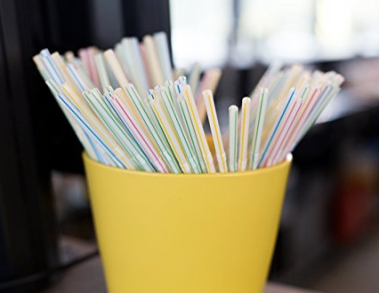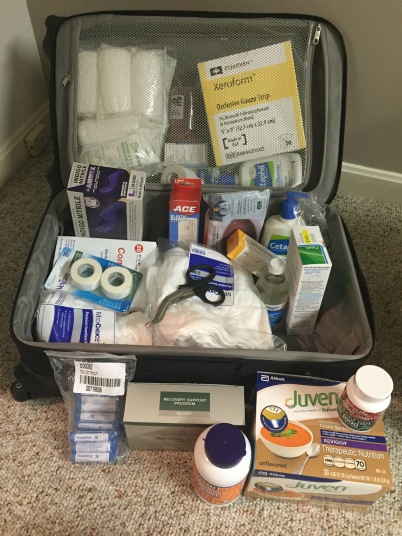
This is a list of the medical-related supplies that I brought with me for surgery. However, some surgeons and the hospitals where they perform surgery will provide a fair amount of these supplies for you, while others require that you bring the majority of your own medical supplies. So be sure to confirm which items you will actually need.
I will not be going over nutritional supplements in this posting because I did a very thorough write up on any orally taken pills, and supplements in a separate blog entitled: Medications, Supplements, & Nutrition Post-Op <— which can be found here.
BUT, If you would like a downloadable or printable and much more succinct version of THIS checklist (which ALSO includes items from all my other packing and preparation lists i.e. Medications, Nutritional Supplements, and Convenience and Comfort Items, look no further: Printable: Phalloplasty Preparation & Packing <—behold, the fruits of my labor :o)
Bowel/Body Prep Supplies
These are specific to Crane and Chen patients but there is likely quite a bit of overlap with other surgeons. Please refer to the preoperative instructions that your surgeon has provided you.
- Magnesium Citrate – 10 fluid ounces (any flavor) This is a saline oral laxative and can be mixed with another clear liquid drink such as gatorade, if you prefer. I just chugged it.
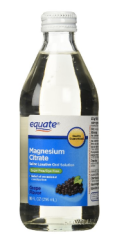
- Twin Pack of Fleet Enemas – These are ALSO saline laxatives, but they go in the other end. One for the night before surgery and one for the morning of. The kit does come with very specific directions for use, so I won’t get into that here.
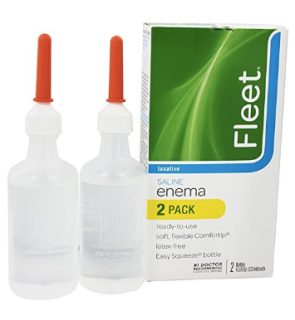
- Stool Softener – Colace, Ducolax, or any generic brand is fine. I bought a bottle of 60 softgels and I still have a ton left, you might be fine with just a bottle of 30. The daily suggested amount on the bottle I have is 1 – 3 soft gels taken all together or split up. If you anticipate needing to be on pain killers for longer than the first week or two, which isn’t uncommon, you may want to spring for a bottle of 60. Constipation is the LAST thing you need when trying to let your perineum heal. You don’t want to be straining. Be sure you start taking stool softeners immediately after surgery as soon as you are allowed to eat. Seriously, this is important. If the nurses don’t give it to you make sure you request it. Set an alarm in your phone to remind you if you don’t have a caretaker to make sure this happens. The combination of anesthesia and narcotics are a perfect storm for severely backed up bowels. Some guys don’t go for well over a week and it can be miserable. I was going by day 4, the night before I left the hospital because I was all over this! I found out the hard way after my hysto and was determined not to have a repeat for phallo.
- Hibiclens: This product is an antimicrobial skin cleanser primarily made up of chlorhexidine gluconate. This agent binds to the skin for 5-6 hours and as a result inhibits bacterial growth. I automatically shower with this the night before and morning of ANY surgical procedure. It was allowed but not required by my surgeon for Stage One (I had to inquire about it). It is however required for Stage Two when implants are being placed, which comes with a much higher risk for infection.
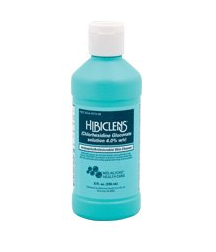
(END OF BOWEL/BODY PREP SUPPLIES)
* * * * * * *
General Medical Supplies
- Medihoney – There are three different main options to choose from here. Patches, Paste, and Gel. You might not really ever need any medihoney. Since it’s fairly pricey for a small amount, I wouldn’t really suggest buying it if you don’t need it. As a side note: I’ve see knock off brands for far cheaper at CVS. I’ll include the 3 that I was familiar with from Amazon which are the brand name. The patches are a calcium alginate dressing that is soaked in medihoney, that one is supposedly for moderately to heavily exuding (oozing, weeping, wet) wounds. The gel and the paste are applied singularly and you can add a dressing over them if you wish to. Keep in mind, that base of this salve is honey – so it’s very sticky stuff:
- Bacitracin or other topical ointment that your doctor prefers. Some surgeons like Schechter use a TON of these tubes for aftercare. I went through more than 1 tube, but less than 2. This is the brand I bought:
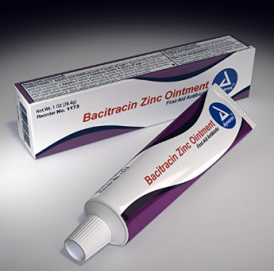
- TAPE: A variety of types might be helpful to have. Cloth, paper, and waterproof are the three basics that I found useful. One roll of each is likely to be more than enough. I probably used the most of the paper tape during my donor site bandage changes:
- Medical Safety Scissors: Any scissors will do, they don’t need to be safety scissors. Of course though, these are much safer to use and greatly reduce the risk that you might stab or cut something you REALLY don’t want to be stabbing or cutting and likely may not feel even if you were injuring yourself:
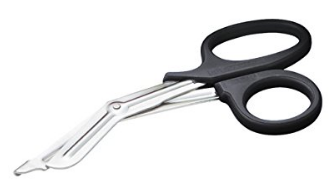
- Handheld Mirror: It doesn’t need to have a handle. I bought one locally for very cheap that was a rectangle and had a little stand on the back. Anything will do, just as long as you’re able to hold it with one hand. This is an essential to be able to scope out hard-to-view surgical sites:
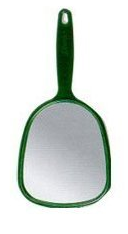
- Flexible Ruler: I suggest getting a small retractable, FLEXIBLE (plastic or fabric) ruler. They are really cheap and the flexible ones allow you to measure length (obviously), but also easily wrap it around things which you can’t do accurately or at all with the thin metal ones. These are often marketed for sewing projects. I also got a TON of use out of mine in the lead up to surgery when I was still contemplating going with ALT. Most people are familiar and able to visualize length, but can rarely estimate the girth of something. But have faith, once you measure the girth of every single semi-phallic object in your house with this thing, you will have joined those who can! I also just liked to know how my body was fluctuating during the healing process and being able to know for sure when swelling was going down or increasing:
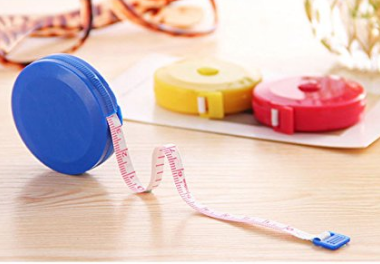
- Gloves: These are helpful for dressing changes, especially if you have someone else helping you with them. I honestly used very few of these, but it wasn’t a bad idea to have them on hand. I bought this brand, but again, any will do:
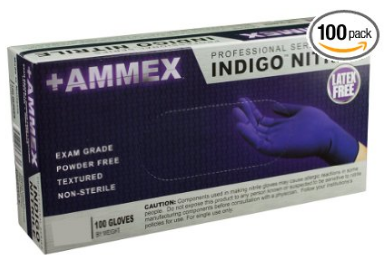
- Ace Bandage: I actually didn’t even need this. I eventually made use of it months down the line just for fun as a wrap over my silicone gel sheet, but really the tubigrip that I got at O.T. was a far more efficient, lightweight, and FREE option. If you are having ALT you might be more likely to use this and it’d probably make sense to go with the wider wrap, such as the 6 inch:
- Self Adherent Wrap: I did use this stuff! It was really handy. There are two main brands: Coban, and also Vetrap. The latter is technically marketed for veterinarian used, but I actually liked that brand best because I was able to order in a wider size (I like the 4 inch) and they also come in a slew of really great colors. As a secondary use, this can also be used as an erection aid once you’re all healed up and cleared for sexual activity. A thin, firmly applied layer with a condom rolled on over the top works well, regardless of whether you’ve had glansplasty:
- Cetaphil: or other gentle skin cleanser equivalent. If you order Cetaphil online, be very careful to make sure you are actually ordering the CLEANSER (soap) if that’s what you are indeed looking to order. I mention this because some of their lotion bottles are the EXACT same with the exception of the words “cleanser” or “cream”:
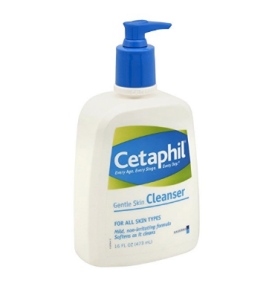
- Extra Dry Skin Lotion: Buy something that has a lot of body to it. Some lotions are really watered down. You want something that’s going to really penetrate the dry scales on your “split thickness”, and “flap” harvest locations once you are cleared to start moisturizing. I went with a very thick, rich version of Eucerin. Yes, it was super greasy, but it got the job done and I didn’t constantly have to reapply. A few other good options would be Lubriderm, shea butter, or coconut oil lotion. Get whatever works for you. Either way, just know you’ll be using a lot of it and for many months, so find something you won’t dread putting on. The more regularly you use it and massage the area the more likely you are to heal faster and reduce your scarring:
- Disposable Wipes: I bought a brand called Adult Wipes (rather than the smaller tiny baby wipes) and I was really satisfied with the purchase. The adult wipes are 12 x 8, they are noticeably larger than a baby wipe and far thicker. I bought a huge case of 240 that had 5 easy one-handed press open packages which then container 48 wipes each. Cases are currently being sold on Amazon for just over $10:
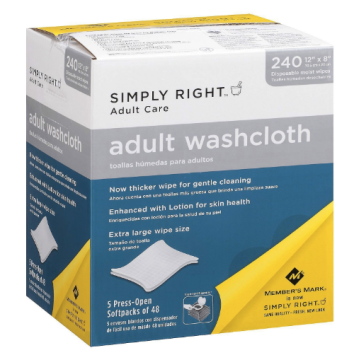
- Antibacterial Hand Wipes: These are very different from just a standard baby or adult wipe which is only going to use moisture to cleanse the area. Having antibacterial hand wipes is really helpful when it’s difficult to get up and frequently wash your hands with real soap and water. The bottled hand sanitizer is also an option too, but I preferred to use the wipes which felt like a cleaner option. These are also great for wiping down and cleaning things like your scissors, mirror, remote control, phone etc. Anything that you’re touching all the time that gets funky fast:
- Thermometer: This tends to be an overlooked item, but an important one. You’re going to want to know if you’re running a fever because that could indicate the presence of an infection. Definitely add this to your suitcase:
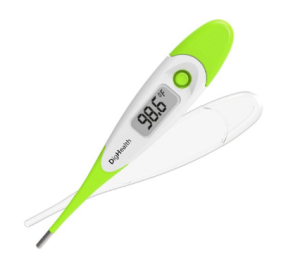 Medical Donut: Don’t buy the inflatable one. Even though it collapses to be more discrete at times, when you need this thing, you need it. In other words it’s more of a hassle to blow up and compress. The other factor with the inflatable is that even though you can decrease that fill with less air so that it’s softer, it still creates more pressure than a foam donut. Some guys don’t end up using it and prefer instead to use a pillow, but I really liked the donut for whenever I had to leave the house. It made sitting in the car during hours of traffic and long post-op appointment waits so much more comfortable. I used it for my STAGE ONE, my perineal revision in June.
Medical Donut: Don’t buy the inflatable one. Even though it collapses to be more discrete at times, when you need this thing, you need it. In other words it’s more of a hassle to blow up and compress. The other factor with the inflatable is that even though you can decrease that fill with less air so that it’s softer, it still creates more pressure than a foam donut. Some guys don’t end up using it and prefer instead to use a pillow, but I really liked the donut for whenever I had to leave the house. It made sitting in the car during hours of traffic and long post-op appointment waits so much more comfortable. I used it for my STAGE ONE, my perineal revision in June.
- Mesh Disposable Underwear: I really liked these! The nice thing is that they’re sturdy enough to hand wash a few times and get some multiple uses out of. I didn’t start wearing regular underwear for quite some time because of areas that were still draining so these came in handy and were really easy to tuck gauze or pads into to either prop and elevate or absorb. My friend got creative with these and made a snip in the front with scissors and used the elasticity of the underwear to keep his penis elevated but not at such a sharp vertical angle! The brand that I like is called Medichoice and I bought the SM/MD size. Again, I’m 5’5 and about 140 lbs:
- Chux Underpads: For sitting on/sleeping on and protecting furniture and bedding. You might also be able to pick up puppy pads that are actually thicker and cheaper at a nearby pet store:
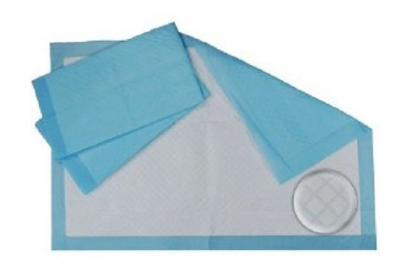
- Kerlix Gauze Rolls: I bought a 10 pack of these and I ended up needing about twice that much. These are pretty big and bulky so you might want to pick them up locally if you’re traveling for surgery. Be careful when ordering online. The size you’re looking for is: 4 1/2″ x 4 1/8 yd. I really didn’t know what these were for prior to having surgery. They’re for lightly wrapping the donor site after you’ve applied the Xeroform material to the wound site:
- Combine Pads: Also called ABD pads. 5 x 9 is the size you’re looking for. These can be used for propping your penis up in an elevated position in underwear, and they’re also really heavy duty absorbent pads. Essentially they are a very crude version of a sanitary napkin but not contoured and they don’t have any wings or adhesive on them. I had a couple times where I had bleeds and the combine pads were a lifesaver. My friend that had surgery 2 days after me hardly used any of his. Some of these supplies you might never use, so you could go bare bones if you want and skip these, but I think having some kind of pads available to you is pretty essential:
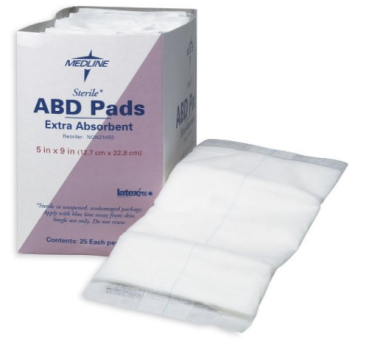
- Xeroform: Ok, I didn’t really know what this weird stuff was before surgery. I had seen it in some videos of people showing bandage changes but I didn’t really know what it was. It’s just a thin yellow piece of cloth that is impregnated with a bacitracin equivalent, that’s it. I bought a box of 50 and had enough to share with a friend. Depending on how large your donor site is, you will need at least one, but possibly 2 or 1 and some change, per dressing change. Dressing changes are done every 1-2 days usually but I’ve heard some guys being told to do them twice a day. Climate could be a factor here, arid locations would cause the ointment to dry out quicker. Ultimately you’ll want to check in with your surgeon about frequency. I used the Xeroform everyday for 3-4 weeks:
- StatLock: Ok, seriously. I wish I had prepared and bought 2 or 3 of these prior to surgery. These are a catheter tube holding device that uses an INSANELY strong glue to adhere to your skin. This is a PRO MOVE guys. You can use tape but I found that utterly frustrating, with constantly re-tapping, and my body and the SP tubing getting completely covered in tape goo. Also the super pubic tubing would roll and twist and kink with the tape. I had one of these Statlocks in the hospital but they didn’t have any to send me home with. CPMC only purchases them as part of an entire catheterization KIT. I got the one place when I was in the OR and then ordered some online but they took close to a week to arrive. They can be a little pricey for just being a sticker ($6) but it’s a solid buy you won’t regret. 2 or 3 will be plenty, you can get almost a full week out of them. DO NOT rip them off, you have to soak it in alcohol or it will tear your damn skin off. Follow the instruction that come with it, the application site needs to be prepped with the packets that come with it and you may want to shave the location or choose a less hairy spot to stick it… Amazon keywords to use if you want the one below which was identical to the one I had in the hospital and purchased online: “STATLOCK Foley Stabilization Device with Foam Anchor Pad with Perspiration Holes”:
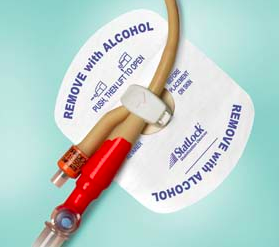
- Alcohol Prep Pads: These are great for getting things to the next level of sanitation that baby wipes, and antibacterial wipes can’t do and aren’t appropriate for. You’ll also NEED them to change/remove your Statlock. Also great for getting all the tape goo off your body from the hospital and dressing changes, or if you end up deciding to ignore my very good advice of using a statlock and instead tape your SP to your body. You’ll be using tons of these to get tape glue of things. Super useful:
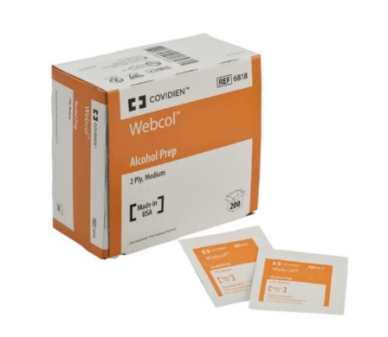
- Pill Baggies: Ok, I got these kind of last minute, the day before my surgery. I had mulled over the idea of using a big plastic pill organizer but most of them were not large enough to hold all the days pills, nor would they fit a packet of Juven, and I didn’t want to dump homeopathic remedies in with the other pills because anything touching them (including the oils from your hands) negatively impact their potency. So, here’s what I did to organize my meds. I essentially had 3 pill times throughout the day and I made a MORNING, NOON, & EVENING pill baggie for each med time. I wrote the intended date on every bag so there could be no confusion for example as to “whether or not I took today’s noon dosage or not”. Anything that I needed to take that was not in the baggie, I wrote directly on the bag, there’s space. I then went a step further and I took the 3 mini dosage bags and I put them inside one daily ziplock sandwich bag and wrote the day/date on it. So I was able to fit the Juven, any other powdered supplements and drop the tubes of homeopathic remedies into the daily bag and keep everything right by the couch, bed, or bring it along with me in the car. This made keeping up with my medications much easier. The first batch I packaged up the night before surgery and I set myself up for close to 2 weeks. By the time I ran out I was feeling up to being able to make another round spanning 2 weeks. Once I ran out of those I was already home and taking far fewer pills/supplements. This was the method that worked best for me. I also used this system with a friend I was supporting after his surgery and he seemed to find it really useful too. There are just FAR too many bottles to be going around opening them all up at each medication time. Even as a once daily task I was SO glad to take it off the list of things I needed to worry about. These are very similar to the bags I used. I found them at my local pharmacy in a pack of 50:
- Bendy Straws: Ok, this isn’t a medical item but it might as well be. These are great to have while you are lying in bed in the hospital and aren’t allowed to sit up in the beginning. Usually the hospital has some, so just grab a handful from them. You can also snag a few at a fast food joint. Or I suppose just buy a small box – they’re dirt cheap for more than you’ll use in 5 years. But definitely have some on hand, it made staying hydrated much easier and enjoyable:
